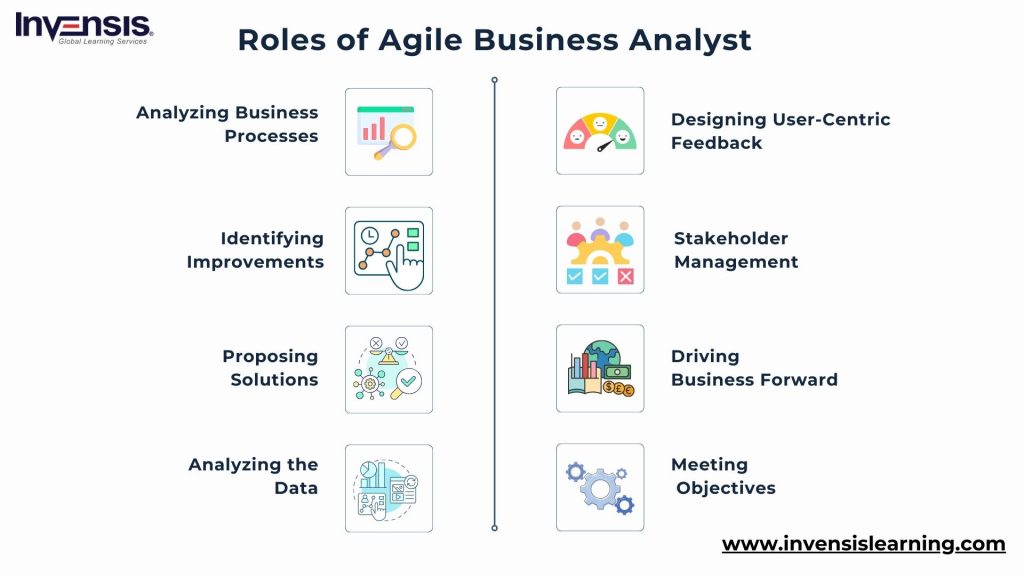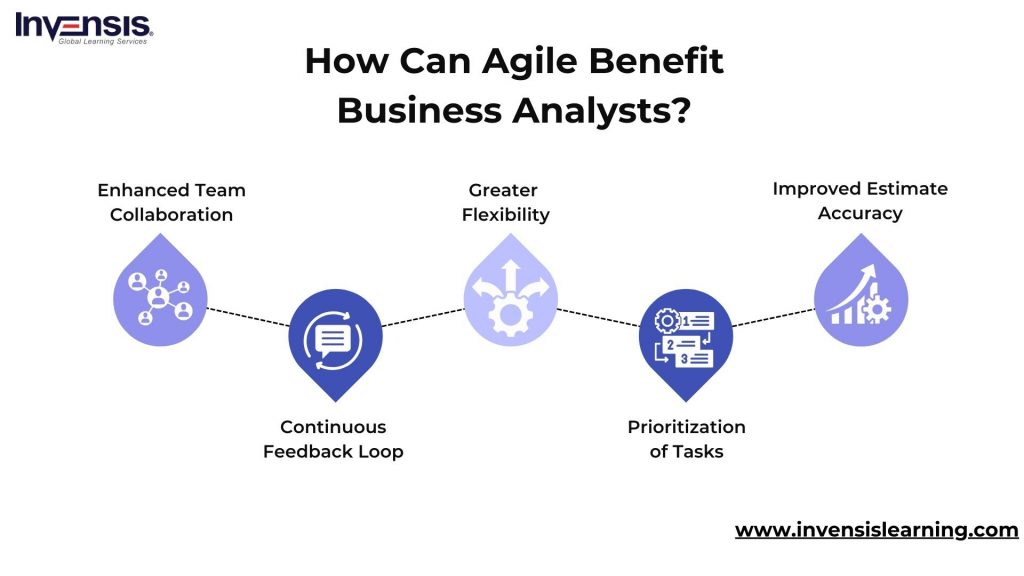
Agile Business Analysts are playing a critical role in helping organizations adapt to fast-changing project environments. With demand for skilled Agile BAs growing steadily, interview preparation has become more competitive than ever. This guide brings together 50 Agile Business Analyst interview questions – beginner, mid-level, and advanced you can sharpen your answers, showcase your Agile mindset, and increase your chances of landing the role.
Table of Contents
- Beginner-Level Agile Business Analyst Interview Questions
- Mid-Level Agile Business Analyst Interview Questions
- Advanced-Level Agile Business Analyst Interview Questions
- Conclusion
Beginner-Level Agile Business Analyst Interview Questions And Answers
If you’re just starting out as an Agile BA, interviewers often focus on core Agile principles, basic BA responsibilities, and your understanding of frameworks like Scrum or Kanban. These beginner-level Agile Business Analyst interview questions test whether you have the right foundation to grow in an Agile environment.
1. What is Agile?
Agile is a dynamic and collaborative approach to software development and project management. It stands out from traditional models like Waterfall by prioritizing flexibility, continuous improvement, and customer satisfaction.
Agile development is carried out in iterative cycles, allowing for regular feedback and adjustments. This approach is underpinned by values and principles emphasizing direct communication, team collaboration, and a readiness to adapt to changes.
2. What is the role of an Agile business analyst in an organization?
An Agile business analyst is a vital bridge within an organization, connecting various stakeholders from different domains. Their role is central to understanding and aligning the needs of these stakeholders with the organization’s goals.
Typical roles and responsibilities of an agile business analyst include:
- Analyzing Business Processes: Examining current processes to identify inefficiencies and areas for improvement.
- Identifying Improvements: Determining key areas where changes can improve performance and results.
- Proposing Solutions: Develop actionable strategies to address identified issues and optimize processes.
- Analyzing the Data: Agile Business Analysts often use data analysis to identify trends, patterns, and insights that can inform decision-making and help craft effective strategies.
- Designing User-Centric Feedback: Agile Business Analysts focus on understanding user needs and preferences. They play a crucial role in user-centric design by gathering user feedback, creating user stories, and ensuring the end product.
- Negotiation and Stakeholder Management: Skillfully negotiating and balancing the needs and requirements of various stakeholders.
- Driving Business Forward: Ensuring that the organization progresses in a unified and effective manner.
- Meeting Objectives Satisfactorily: Achieving business goals while ensuring satisfaction among all involved parties.
3. What is the difference between a data analyst and a business analyst?
Here’s the information presented in a tabular format:
| Context | Data Analyst | Business Analyst |
| Focus | Analyzing large datasets to identify trends, patterns, and correlations | Understanding and improving business processes |
| Key Activities | Statistical and mathematical modeling, data cleaning, transformation, and analysis | Gathering requirements, mapping business processes, identifying areas for improvement |
| Tools and Technologies | SQL, Python, R, Tableau, Excel | BPMN, UML, JIRA, Excel, PowerPoint |
| Objective | Inform decision-making through empirical data findings. | Align business processes with stakeholder needs and organizational goals |
| Approach | Data-centric, focusing on quantitative analysis | Process and stakeholder-oriented, focusing on qualitative analysis |
4. Why should companies adopt Agile methods?
Adopting Agile methods offers companies a powerful, flexible product development and project management framework. Agile’s adaptability allows teams to respond swiftly to changes, making it ideal for dynamic business environments. It encourages continuous feedback and iteration, ensuring that the end product aligns closely with customer needs and market trends.
Agile promotes cross-functional collaboration, breaking down silos within organizations and fostering a more cohesive and innovative work culture. This leads to higher quality outcomes and a more motivated and engaged workforce.
By adopting Agile, companies position themselves to be more responsive, competitive, and customer-centric in their operations.
5. How can Agile benefit business analysts?
As a Business Analyst, adopting Agile methodology can significantly enhance your efficiency and effectiveness.
Agile’s iterative nature, which emphasizes collaboration, adaptability, and continuous feedback, offers several advantages:
- Enhanced Team Collaboration: Agile fosters close cooperation between Business Analysts and team members, ensuring alignment and a clear understanding of requirements.
- Continuous Feedback Loop: Agile enables ongoing feedback, allowing Business Analysts to adjust their approach based on input from users and colleagues.
- Greater Flexibility: Agile’s adaptable framework is beneficial in accommodating changes and addressing unforeseen challenges, surpassing the rigidity of traditional methods.
- Prioritization of Tasks: Agile aids Business Analysts in focusing on high-priority tasks, facilitating the timely completion of critical work.
- Improved Estimate Accuracy: The regular feedback and iterative process in Agile helps in early error detection, enhancing the accuracy of estimates.
6. Can you describe some Agile business analysis techniques?
Agile business analysis involves various techniques that cater to dynamic business needs and enhance operational efficiency.
For instance:
- Backlog Refinement: This involves managing and continually reviewing pending tasks and business requirements, ensuring efficiency.
- User Story Mapping: This technique creates narratives based on user research, setting standardized criteria for customer satisfaction.
- Personas: In developing a new mobile application, we used personas to understand the target audience, incorporating detailed information like background and needs.
Master Agile principles with Invensis Learning’s industry-recognized Agile Certification courses!
7. What are the core competencies of a business analyst?
A Business Analyst must embody several core competencies:
- Exceptional Communication and Negotiation Skills: These are crucial for effective stakeholder engagement and conflict resolution.
- Analytical Thinking and Problem-Solving: Vital for identifying issues and devising practical solutions.
- Decision-Making: Necessary for making informed choices that benefit the organization.
- Industry Knowledge and Business Process Management: Understanding the industry and managing business processes efficiently is key.
- Technical Proficiency: Familiarity with relevant technologies and processes.
8. What technical skills do you possess, particularly in databases and business intelligence?
Technical knowledge isn’t mandatory for an Agile BA, but it adds significant value when bridging business and IT teams.
Key Points:
- Databases & BI: Basic SQL and familiarity with reporting tools (e.g., Tableau, Power BI).
- Agile tools include JIRA: Confluence, and Trello for managing requirements and tracking progress.
- Modeling Techniques: UML, BPMN for visualizing workflows.
- Data Awareness: Ability to interpret data trends to support decision-making.
- Closing Insight: A well-rounded BA may not code, but should be comfortable enough with tools and data to speak both the business and technical language.
9. Can you discuss techniques like MoSCoW and SWOT in business analysis?
In Business Analysis, understanding and applying various techniques like MoSCoW and SWOT is crucial. MoSCoW, which stands for Must or Should, Could or Would, is a prioritization technique.
It involves evaluating each requirement’s importance to determine if it’s a necessity (Must have) or a lower priority (Should, Could, or Would have). This method aids in efficiently organizing project requirements.
Another fundamental technique is SWOT Analysis, which identifies Strengths, Weaknesses, Opportunities, and Threats. It allows a Business Analyst to evaluate an organization’s position and capabilities, turning insights into actionable strategies.
10. How is the role of a Business Analyst different in Agile vs. Waterfall?
Business Analysts operate very differently in Agile projects compared to Waterfall.
Key Points:
- In Waterfall: BA gathers requirements upfront, creates detailed documentation, and hands off to development.
- In Agile: BA works iteratively, writing user stories, refining backlog, and engaging with stakeholders throughout the sprint.
- Shift in Mindset: From being a translator of requirements → to being a continuous collaborator and change facilitator.
- Closing Insight: In Agile, the BA becomes an active team member, not just a bridge, helping ensure evolving business needs are always aligned with delivery.
11. Could you explain the differences between Agile and Scrum?
While Agile and Scrum are often used interchangeably, they have distinct differences. Agile is a broad methodology or philosophy for software development that emphasizes flexibility, iterative development, and collaboration.
It’s a mindset or approach that can be applied in various ways.
Scrum, on the other hand, is a specific implementation of Agile. It’s a framework that provides a structured process involving sprints, stand-up meetings, and roles like Scrum Master and Product Owner. While Scrum adheres to Agile principles, it’s more prescriptive in its methods and practices.
12. How does an Agile project lifecycle differ from a traditional project lifecycle?
Both Agile and traditional projects have lifecycles, but the way they progress is fundamentally different.
Key Points:
-
- Traditional Lifecycle: Linear phases—Initiation → Planning → Execution → Monitoring → Closure.
- Agile Lifecycle: Iterative cycles—Plan → Develop → Review → Adapt (repeated in sprints).
- Stakeholder Role: Traditional = feedback mostly at start and end; Agile = continuous engagement.
- Flexibility: Traditional assumes fixed scope; Agile embraces change at any stage.
- Closing Insight: Agile lifecycles don’t eliminate structure—they replace rigid steps with adaptable loops that keep the product aligned with real user needs.
Mid-Level Agile Business Analyst Interview Questions and Answers
In the Mid-Level Agile Business Analyst Interview Questions section, you can explore queries aimed at individuals with experience in the Agile environment. These questions are crafted to probe deeper into the practical application of Agile methodologies and business analysis skills.
They offer an opportunity for candidates to showcase their hands-on experience, problem-solving capabilities, and how they’ve navigated real-world Agile project scenarios.
For interviewers, this segment provides a framework to assess a candidate’s proficiency in managing complex tasks and ability to contribute effectively to an Agile team. It’s an essential guide for understanding and evaluating the competencies required for a mid-level position in Agile business analysis.
13. How do you collaborate effectively with Agile teams as a business analyst?
Collaboration with Agile teams requires a Business Analyst to communicate and manage diverse expertise within the team effectively.
My approach involves clearly articulating requirements and ensuring all team members understand their roles and goals. Flexibility is key, as Agile projects often evolve based on feedback or new insights.
Additionally, I focus on tracking progress and swiftly identifying and addressing any emerging challenges that may arise. This approach aligns the team and contributes significantly to the project’s success in an Agile environment.
14. Can you explain the difference between requirements and needs in a project context?
In the context of a project, a requirement is a specific condition or capability that must be met or possessed by a system or project outcome. It’s a detailed, documented representation to achieve particular objectives.
On the other hand, needs are more high-level, general expressions of desired outcomes or goals. For instance, securing a Business Analyst position is a need, and the requirements to achieve this include a resume, educational qualifications, and interview preparation.
15. What unique strengths make you effective as an Agile Business Analyst?
My strengths include clear communication, backlog management, and stakeholder alignment. I adapt quickly to changes, facilitate collaboration between technical and business teams, and ensure user stories are prioritized to deliver maximum value within sprints.
16. How do you engage with stakeholders in an Agile environment?
Managing stakeholder expectations in an Agile environment is crucial. Agile’s fast-paced nature means stakeholders might need more input during the development phases. To mitigate this, I ensure stakeholders are involved from the project’s onset, incorporating their inputs in the planning and priority-setting stages.
Transparency about the development process and regular feedback opportunities are also vital. This inclusive approach helps balance the Agile methodology’s rapid progression with stakeholders’ need for involvement and ensures a harmonious and effective project environment.
17. What additional strengths do you bring to this role?
I have key strengths like:
- Adaptability: I quickly adjust to new environments and challenges, which is vital in dynamic project settings.
- Critical Thinking: I excel at analyzing situations and developing logical, effective solutions.
- Team Leadership: My experience in leading and motivating teams ensures project success.
- Communication Skills: I am adept at conveying complex ideas clearly to diverse audiences.
- Time Management: I prioritize tasks effectively, ensuring efficient project progress.
18. How do you apply business modeling techniques in Agile projects?
I use lightweight, just-enough models to clarify value and flow without slowing the team.
- Context & scope: Context diagrams and SIPOC define boundaries and external actors.
- Process clarity: BPMN flows, or value stream maps reveal handoffs, bottlenecks, and NFR hotspots (performance, security).
- Discovery to delivery: Event storming and user story mapping translate domain events into epics/stories with a clear release slice.
- Decision alignment: Impact mapping connects business goals → user behaviors → features, keeping scope tied to outcomes.
Example: for a checkout revamp, a simple BPMN plus story map exposed edge cases (guest vs. registered flows, promo stacking). We turned them into specific stories and test scenarios, which cut rework in later sprints.
19. Are BRDs and SRS still relevant in Agile? What do you use instead?
In Agile, static, exhaustive BRDs/SRS are usually replaced by living artifacts:
- Vision & roadmap for direction; epics/stories with acceptance criteria for scope.
- Definition of Ready/Done, NFR catalog (performance, security, accessibility), and ADRs (architecture decision records) for traceability.
- Confluence/Jira pages as the single source of truth, updated sprint-to-sprint.
That said, I may produce a lightweight BRD or statement of scope when contracts, audits, or regulated environments demand a formal baseline, kept concise and linked to the live backlog to avoid drift.
20. How do you stay updated on business trends and knowledge?
For me to be updated on business trends, I will be:
- Regular Reading: I keep up with news and publications specific to my industry.
- Professional Networking: I attend events and conferences to connect with peers and experts.
- Continuous Learning: I use online courses and webinars to enhance my skills.
- Industry Forums: Participation in online forums and discussions for real-time industry insights.
- Feedback and Reflection: I regularly seek feedback and reflect on my experiences for continuous improvement.
21. How does Agile alter the business analyst’s role?
In Agile development, the Business Analyst’s role evolves significantly from the traditional Waterfall model
- In Waterfall
- Acts as a liaison between stakeholders and the development team.
- Translates business demands into clear, actionable requirements for product development.
- In Agile
- Plays a central role in ensuring the team understands the business objectives.
- Requires a deep understanding of both business needs and technological capabilities.
- Engages in rapid prototyping and gathering stakeholder feedback.
- Shifts from being a requirements translator to a proactive change agent.
22. What does INVEST stand for in business analysis?
INVEST, a key concept in Agile and project management, stands for:
- Independent: Each item should be self-contained, minimizing dependencies
- Negotiable: Requirements are open for discussion and adaptation
- Valuable: Every item must deliver value to the customers
- Estimable: Items should be quantifiable in terms of effort and resources
- Sized Appropriately: Work items should be a manageable size
- Testable: Each requirement must be verifiable and testable
23. Can you describe your role in Agile ceremonies like Sprint planning and retrospectives?
Sprint Planning
- Facilitate discussions to define sprint goals and select backlog items.
- Help the team understand and break down complex user stories.
Retrospectives
- Lead the team in reviewing the sprint, focusing on achievements and areas for improvement.
- Encourage open, constructive feedback to enhance future sprints.
24. How do you prioritize user stories and backlog items?
Prioritizing user stories and backlog items involves:
- Assessing Business Value: Evaluating how each item aligns with strategic goals and customer needs.
- Stakeholder Input: Gather and consider feedback from stakeholders to understand priorities.
- ROI Analysis: Analyzing potential return on investment for each item.
- Urgency and Impact: Considering each item’s urgency and potential impact on the project’s success.
- Dependencies and Risks: Identifying dependencies and potential risks associated with each item.
Advanced-Level Agile Business Analyst Interview Questions
The Advanced-Level Agile Business Analyst Interview Questions section focuses on complex and challenging inquiries tailored for seasoned professionals deeply entrenched in the Agile framework.
This segment tests a candidate’s expert-level understanding of Agile principles, strategic thinking, and capacity to handle high-level analytical tasks. It’s an arena for candidates to demonstrate their leadership qualities, innovative problem-solving skills, and proficiency in successfully driving Agile projects.
25. How can a business analyst support an Agile team in achieving its goals?
A Business Analyst plays a pivotal role in guiding an Agile team towards its objectives:
- Stakeholder Identification: Recognize and understand the project’s stakeholders and their goals to align the team’s efforts.
- Requirement Gathering: Collect detailed requirements from stakeholders to develop user stories and guide the development process.
- Monitoring Project Progress: Keep track of the project’s advancement, spot potential risks or challenges, and suggest necessary schedule or scope adjustments.
- Facilitating Communication: Act as a communication bridge between stakeholders and the development team, ensuring clarity and alignment.
26. How have you collaborated with technical teams in past roles?
In previous roles, my approach to collaborating with technical teams involved:
- Clear Communication: Ensuring both sides communicated all technical requirements and objectives clearly and understood.
- Regular Check-ins: Establish routine meetings to update feedback and address any emerging issues.
- Problem-Solving: Collaborating closely to troubleshoot and resolve technical challenges as they arise.
- Knowledge Sharing: Facilitating mutual learning and understanding between business and technical teams.
27. How do you contribute to project management as a Business Analyst in Agile projects?
As a Business Analyst, I don’t directly manage projects like a Project Manager would, but I play a key role in ensuring projects run smoothly.
My contribution lies in:
- Clarifying Scope: I collaborate with the Product Owner and stakeholders to ensure that backlog items are well-defined, prioritized, and aligned with business objectives.
- Facilitating Communication: I act as a bridge between business and technical teams, reducing miscommunication and delays.
- Supporting Planning: During sprint planning, I provide clarity on requirements and dependencies, so the team can commit to realistic goals.
- Tracking Progress: I monitor delivery against business outcomes, raise risks early, and ensure the product meets acceptance criteria.
This way, I indirectly support project management by enabling better decision-making, minimizing blockers, and ensuring alignment between delivery and business goals.
28. How do you manage resistance to change during Agile transformations?
Addressing resistance to change involves:
- Open Communication: Encouraging honest discussions about concerns and apprehensions.
- Stakeholder Involvement: Involving team members and stakeholders early in the process.
- Education and Training: Providing sufficient training and resources to understand and adapt to Agile methodologies.
- Demonstrating Benefits: Showcasing the advantages of Agile to highlight its value.
- Feedback Loop: Establishing a feedback mechanism to address concerns and make adjustments.
- Supportive Environment: Creating a supportive atmosphere that fosters adaptation and growth.
29. How does Agile manifest in business practices?
Agile principles have significantly influenced business operations in several ways:
- Customer-Centric Approach: Agile businesses prioritize customer feedback, using it actively to refine products and services.
- Collaborative Culture: There’s a strong focus on cross-functional team collaboration, enhancing innovation and problem-solving.
- Continuous Improvement: Agile organizations are committed to streamlining processes, always seeking efficiency and effectiveness in their operations.
- Adaptability: Agile businesses quickly respond to market changes, ensuring they remain competitive and relevant.
30. Do you have experience with Agile estimation tools? Can you elaborate?
Yes, I have experience with various Agile estimation tools:
- Planning Poker: Planning Poker is a consensus-based technique that allows team members to make estimates by playing numbered cards face down.
- Bucket System: Placing items into “buckets” or categories based on complexity or size. These tools help create more accurate estimates by involving the entire team, ensuring a shared understanding of tasks and their complexity.
31. What types of diagrams do you use in business analysis, and what impact do they have?
As a Business Analyst, I utilize several diagrams:
- Flowcharts: To depict the complete flow of systems, making it understandable for all stakeholders.
- Activity Diagrams: Illustrate activities across departments and identify operational flows.
- Use Case Diagrams: Modeling system functionality to visualize functional requirements and development priorities.
- Sequence Diagrams: Showing interactions between objects and the timing of message flows.
- Collaboration Diagrams: Demonstrating relationships and interactions among software objects.
These diagrams are instrumental in visualizing complex processes, aiding requirement analysis, and influencing project direction.
32. Can you describe your approach to user acceptance testing and ensuring high-quality deliverables?
My approach to User Acceptance Testing (UAT) and quality assurance includes:
- Thorough Planning: Developing a clear UAT plan that aligns with business requirements.
- Collaboration with stakeholders: Engage with end-users and stakeholders to define UAT criteria and scenarios.
- Regular Reviews and Testing: Conducting iterative testing sessions and incorporating feedback.
- Documentation: Maintaining detailed documentation of tests, results, and feedback.
- Quality Checks: Implementing multiple checks to ensure deliverables meet the agreed standards.
- Feedback Implementation: Adjusting deliverables based on user feedback to ensure they align perfectly with user needs and expectations.
33. What is your opinion on the future evolution of an Agile business analyst role?
The role of the Agile Business Analyst is poised for a significant evolution in the future. As businesses navigate an increasingly competitive global market, the demand for quick and informed decision-making is at an all-time high.
Agile Business Analysts will become even more integral in understanding customer behavior, market trends, and the broader business environment. They will be expected to deliver more detailed and sophisticated analysis, leveraging emerging technologies and data analytics tools.
In the future, innovation, adaptability, and agility will be key traits of successful Business Analysts.
They will need to quickly adapt to changing market conditions and customer needs, providing insights that enable businesses to stay ahead. The ability to synthesize complex data into actionable intelligence will be critical.
Furthermore, Agile Business Analysts will likely play a larger role in strategic decision-making, using their insights to influence business direction and innovation.
34. How do you influence multiple stakeholders and work with difficult ones?
Influencing multiple stakeholders in a project requires communication, negotiation, and collaboration skills. My approach involves:
- Understanding each stakeholder’s priorities and concerns.
- Aligning them with the project’s objectives.
- Finding common ground.
- Regular communication and transparency are key to keeping stakeholders engaged and informed.
Dealing with difficult stakeholders involves a strategic approach. I use the STAR (Situation, Task, Action, Result) method to navigate such scenarios.
For instance, I once dealt with a stakeholder who resisted a necessary change in project scope.
By empathizing with their concerns (Situation), clarifying the project goals (Task), engaging in open dialogue to address their reservations (Action), and demonstrating the benefits of the change (Result), I was able to turn the situation around, resulting in successful project adaptation and stakeholder satisfaction.
35. What techniques do you use to size and estimate user stories accurately during sprint planning?
Accurate sizing and estimation ensure that teams commit realistically. The techniques I use include:
- Planning Poker: Encourages consensus by having each team member independently estimate story points and then discuss differences.
- Relative Estimation: Comparing new stories to completed ones of known size to maintain consistency.
- Splitting Stories: Breaking down large or vague user stories into smaller, testable ones that fit comfortably into a sprint.
- Using Historical Data: Referring to team velocity and past performance to validate estimates.
This combination of collaborative techniques and data-driven checks helps ensure that sprint commitments are both realistic and achievable.
36. Can you describe a situation where you had to adapt Agile principles to fit the specific needs of a project or organization?
Certainly, in one of my previous roles, I encountered a project where the standard Agile methodology needed significant adaptation to align with the organization’s unique requirements.
The project involved a cross-functional team that included members who were new to Agile practices, and it was part of a larger program with fixed deadlines and deliverables that were only somewhat suited to the typical iterative Agile approach.
I recognized these challenges and tailored the Agile principles to fit the project’s context. Instead of the usual two-week sprints, we implemented longer sprint cycles to accommodate the team’s learning curve and the tasks’ complexity.
This allowed for more thorough planning and reflection, easing the team into the Agile process without overwhelming them. Additionally, to address the fixed deadlines, I integrated elements of the Waterfall methodology, particularly in the early phases of the project, to ensure that critical milestones were met.
Throughout the project, continuous communication and feedback loops with stakeholders were crucial. We held frequent meetings to discuss progress, challenges, and adaptations. This approach ensured that the team could embrace Agile principles while respecting the project’s and organization’s specific constraints and requirements.
The project was completed on time by adapting Agile in this manner, and the team gradually became more comfortable and proficient with Agile practices. This experience highlighted the importance of flexibility and the need to tailor methodologies to suit the specific context of a project or organization.
Conclusion
Preparing for an Agile Business Analyst interview goes beyond memorizing definitions; it’s about showing how you apply Agile principles in real-world scenarios. From beginner-level fundamentals to mid-level techniques and advanced leadership skills, each question allows you to demonstrate your adaptability, problem-solving ability, and Agile mindset.
By practicing these Agile Business Analyst interview questions and answers, you’ll be able to:
- Communicate requirements clearly to stakeholders and teams.
- Showcase practical experience with Agile tools and techniques.
- Position yourself as a collaborative partner who drives value in every sprint.
If you’re serious about advancing your career, consider enrolling in industry-recognized Agile Certification courses with Invensis Learning. These programs provide the frameworks, tools, and case studies to help you stand out in a competitive job market and step confidently into your next Agile BA role.
















